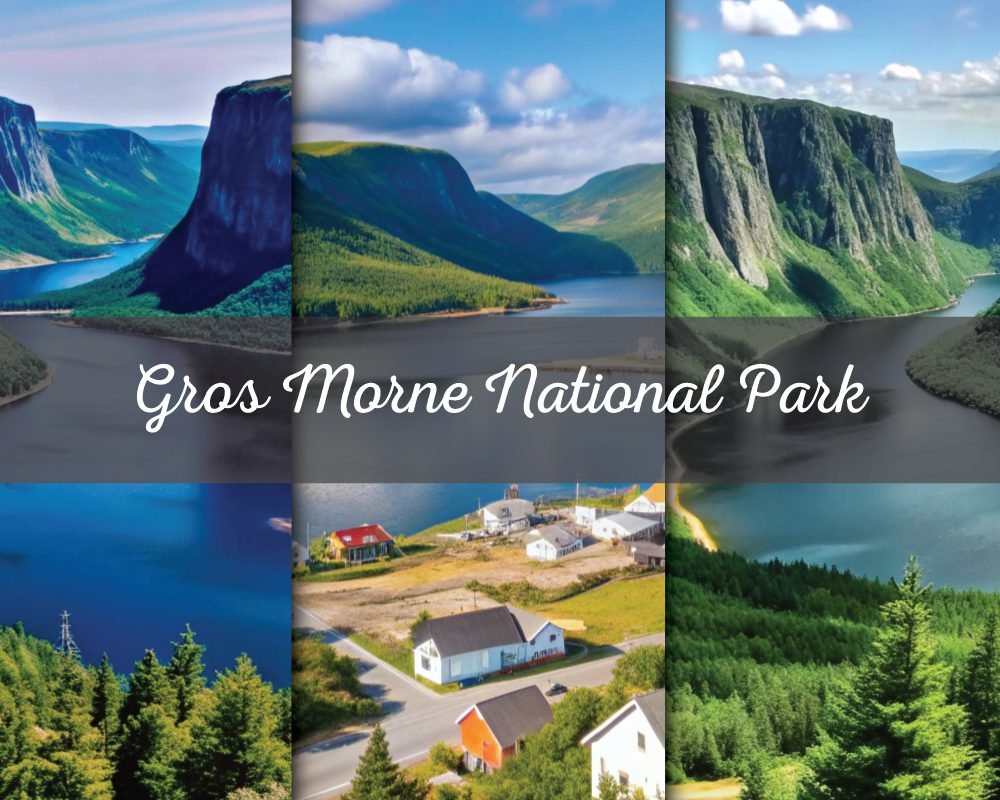
Table of Contents
Introduction:
Nestled on the western coast of Newfoundland and Labrador, Gros Morne National Park stands as a testament to the geological wonders and natural beauty that define Canada. Designated as a UNESCO World Heritage Site in 1987, Gros Morne is a haven for outdoor enthusiasts, geologists, and nature lovers alike. Spanning 1,805 square kilometers, the park encapsulates a diverse range of landscapes, from towering cliffs and fjords to boreal forests and alpine plateaus. In this exploration of Gros Morne, we will uncover the park’s geological significance, ecological diversity, and the myriad experiences it offers to those who venture into its breathtaking landscapes.

Geological Marvels: A Journey through Time
Gros Morne’s most captivating feature is its geological tapestry, a canvas showcasing the Earth’s tumultuous history. The park is home to some of the most striking examples of plate tectonics and glacial action on the planet. At the heart of this geological theater is the Tablelands, a surreal landscape of rust-red rocks that appear more Martian than terrestrial.
The Tablelands provide a window into the Earth’s mantle, offering a rare opportunity to witness the exposed rocks from the Earth’s mantle, pushed to the surface through tectonic forces over millions of years. Guided hikes through this otherworldly terrain lead visitors on a journey through geological epochs, revealing the forces that shaped not only Gros Morne but also the entire planet.
The Breathtaking Fjords: Bonne Bay and Western Brook Pond
Gros Morne is blessed with two majestic fjords that cut into its coastline, creating dramatic landscapes of sheer cliffs, cascading waterfalls, and mirror-like waters. Bonne Bay, with its sheltered waters and charming coastal communities, provides a perfect introduction to the park’s coastal beauty.
However, the true gem lies further inland at Western Brook Pond, a freshwater fjord surrounded by towering cliffs. Boating tours through Western Brook Pond offer a unique perspective on Gros Morne’s glacially-carved landscapes, providing access to waterfalls, wildlife, and the sheer immensity of the cliffs that rise like sentinels along the shores.

Hiking Adventures: Gros Morne’s Trails Unveiled
For those seeking a more intimate exploration of Gros Morne’s diverse ecosystems, the park boasts an extensive network of hiking trails. From gentle strolls along coastal paths to challenging ascents of Gros Morne Mountain itself, there’s a trail for every level of hiker.
- Gros Morne Mountain Trail: The pinnacle of hiking experiences in the park, this challenging trail leads to the summit of Gros Morne Mountain, offering panoramic views of the surrounding landscapes, fjords, and the distant Gulf of St. Lawrence.
- Green Gardens Trail: A coastal hike that unveils stunning sea cliffs, meadows, and the remnants of a once-thriving fishing community, Green Gardens is a perfect blend of history and natural beauty.
- Coastal Trail: This multi-day trek allows hikers to explore the park’s rugged coastline, camping along the way while enjoying breathtaking views of the ocean and cliffs.

Unique Flora and Fauna: A Boreal Symphony
Gros Morne National Park is a haven for biodiversity, boasting a rich array of plant and animal life. The park’s boreal forests, tundra plateaus, and coastal ecosystems provide a home for diverse species, from iconic moose and caribou to elusive Arctic hare and ptarmigan.
The coastal cliffs serve as nesting grounds for countless seabirds, including puffins, guillemots, and kittiwakes. Birdwatchers will find Gros Morne an avian paradise, especially during the nesting season when the cliffs come alive with the cacophony of seabird colonies.
Cultural Heritage: Stories of the Past
Beyond its geological and ecological wonders, Gros Morne National Park carries a rich cultural history shaped by Indigenous peoples and European settlers. The park’s landscapes served as hunting and fishing grounds for the Mi’kmaq and Beothuk peoples for thousands of years.
The remnants of European influence, including the historic Gros Morne Theatre Festival, which celebrates local culture through music and drama, add another layer to the park’s cultural tapestry. The nearby community of Woody Point provides a glimpse into the region’s maritime heritage with its colorful houses and lively waterfront.
Gros Morne National Park 3-Day Adventure Itinerary
Day 1: Introduction to Gros Morne
- Morning: Arrival in Rocky Harbour
- Arrive in Rocky Harbour, a charming community at the doorstep of Gros Morne National Park.
- Check into your chosen accommodation, whether it’s a cozy inn or a campground.
- Late Morning: Gros Morne Visitor Centre
- Visit the Gros Morne Visitor Centre to gather maps and information.
- Explore the exhibits to gain insights into the park’s geology and natural features.
- Afternoon: Coastal Trail
- Begin your Gros Morne adventure with the Coastal Trail.
- A moderate hike offering breathtaking views of the coastline, sea stacks, and potential wildlife sightings.
- Evening: Sunset at Lobster Cove Head Lighthouse
- Drive to Lobster Cove Head Lighthouse for a stunning sunset view.
- Dinner at a local restaurant in Rocky Harbour.

Day 2: Into the Heart of Gros Morne
- Morning: Gros Morne Mountain Trail
- Embark on the challenging Gros Morne Mountain Trail.
- Witness panoramic views of Bonne Bay and the Tablelands from the summit.
- Afternoon: Picnic at Trout River Pond
- Enjoy a well-deserved picnic lunch at Trout River Pond.
- Relax and soak in the serene surroundings.
- Late Afternoon: Boat Tour of Western Brook Pond
- Experience the iconic Western Brook Pond Boat Tour.
- Marvel at the towering cliffs and cascading waterfalls within the freshwater fjord.
- Evening: Dinner in Trout River
- Head to the nearby town of Trout River for a delightful seafood dinner.
- Return to Rocky Harbour for a restful evening.
Day 3: Tablelands and Departure
- Morning: Tablelands Hike
- Explore the surreal landscapes of the Tablelands.
- A guided hike or self-guided exploration, revealing the Earth’s mantle and unique flora.
- Late Morning: Green Gardens Trail
- Opt for a shorter hike along the Green Gardens Trail.
- Discover coastal meadows and the remnants of a historic fishing community.
- Afternoon: Lunch and Relaxation
- Enjoy a leisurely lunch in Rocky Harbour.
- Spend the afternoon exploring the town, shopping for souvenirs, or relaxing by the water.
- Evening: Departure or Stargazing
- If departing, bid farewell to Gros Morne National Park.
- If staying overnight, consider stargazing in this designated Dark Sky Preserve.
Conclusion: Preserving a Natural Legacy
In the heart of Newfoundland and Labrador, Gros Morne National Park stands not only as a testament to the Earth’s geological evolution but also as a sanctuary of biodiversity and natural beauty. Its designation as a UNESCO World Heritage Site underscores its significance on a global scale, and the park’s managers and stewards work tirelessly to balance the needs of conservation with the desire to share this natural wonder with visitors.
As you traverse the rugged trails, gaze upon the fjords, and immerse yourself in the diverse ecosystems of Gros Morne, remember that you are treading upon a landscape shaped by the forces of time and nature. In preserving Gros Morne National Park, we ensure that this geological masterpiece and ecological haven will continue to captivate and inspire generations to come.
Support Us with Crypto!
If you enjoy our content and want to help keep this site running, you can support us with crypto.
Your support is appreciated!

Tron Network: USDT (TRC20)
Popular hotels near Gros Morne National Park
Also read our recent blog – Yoho National Park: A Symphony of Alpine Splendor in British Columbia 2024
Where is Gros Morne National Park located?
Gros Morne National Park is located on the west coast of Newfoundland and Labrador, Canada. It covers a vast area of 1,805 square kilometers and is known for its diverse landscapes, including fjords, mountains, and coastal cliffs.
What makes Gros Morne National Park unique?
Gros Morne National Park is unique for its outstanding geological features, including the Tablelands – an area showcasing Earth’s mantle. The park’s diverse ecosystems, fjords, and striking landscapes contribute to its UNESCO World Heritage Site designation.
How do I get to Gros Morne National Park?
The main entry points to Gros Morne National Park are the towns of Rocky Harbour and Trout River. Visitors can access the park by car or bus. The Deer Lake Regional Airport is the nearest airport, and there are also ferry services available.
Are there entrance fees for Gros Morne National Park?
Yes, there are entrance fees for Gros Morne National Park. Fees vary depending on the type of entry (day pass, annual pass, etc.). It’s recommended to check the official Parks Canada website for the latest fee information.
What are the must-see attractions in Gros Morne National Park?
Some must-see attractions in Gros Morne National Park include:
Gros Morne Mountain and its challenging hiking trail.
Western Brook Pond for boat tours through a glacial fjord.
The Tablelands, showcasing exposed Earth’s mantle rocks.
Coastal Trail for stunning views of the coastline.
What outdoor activities are available in Gros Morne National Park?
Gros Morne offers a range of outdoor activities, including hiking, boating, birdwatching, and stargazing. There are trails for various skill levels, boat tours to explore fjords, and designated areas for wildlife observation.
Can I camp in Gros Morne National Park?
Yes, camping is available in Gros Morne National Park. There are both front-country and backcountry campsites. Reservations are recommended, especially during peak seasons. Campers can choose between developed campgrounds or more secluded backcountry sites.